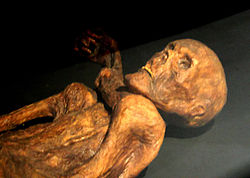Evolution
Similar DNA sequences and their encoded proteins are found in different species. This similarity is directly linked to the sequence of the DNA (the genetic material of the organism). Due to the improbability of this being random chance, and its consistency too long to be attributed to convergence by natural selection, these similarities are best explained by common ancestry. This allows DNA sequences to be compared between species. Comparing an ancient genetic sequence to later or modern ones can be used to determine ancestral relations, while comparing two modern genetic sequences can determine, within error, the time since their last common ancestor.
Ancient DNA research allows scientists to uncover how past organisms lived, including insights into their health, genetics, and interactions with their environment. A method used is called metagenomics which studies all the DNA in an environmental sample to identify different organisms
Human evolution
Genetic data can provide a new understanding for the evolution of human genes and how diseases are transmitted. Ancient archaeological human remains have been a way to see how human structure has changed over time.
Using the thigh bone of a Neanderthal female, 63% of the Neanderthal genome, allowing comparison of billions of bases to the modern human genome. It showed that Homo neanderthalensis were the closest living relative of Homo sapiens, until the former lineage died out 30,000 years ago. The Neanderthal genome was shown to be within the range of variation of those of anatomically modern humans, although at the far periphery of that range of variation. Neanderthals and modern humans share more DNA with each other than either does with chimpanzees. It was also found that Neanderthals were less genetically diverse than modern humans, which indicates that Homo neanderthalensis grew from a group composed of relatively few individuals. DNA sequences suggest that Homo sapiens first appeared between about 130,000 and 250,000 years ago in Africa.
Paleogenetics opens up many new possibilities for the study of hominid evolution and dispersion. By analyzing the genomes of hominid remains, researchers can trace their lineage and estimate common ancestry. The Denisova hominid, a species of hominid found in Siberia from which DNA was able to be extracted, may show signs of having genes that are not found in any Neanderthal nor Homo sapiens genome, possibly representing a new lineage or species of hominid.

